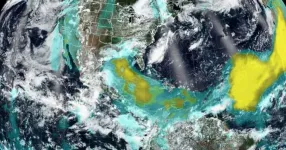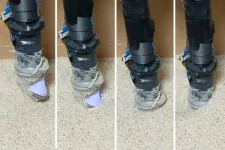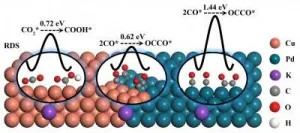(Press-News.org) LAWRENCE -- For two weeks in June 2020, a massive dust plume from Saharan Africa crept westward across the Atlantic, blanketing the Caribbean and Gulf Coast states in the U.S. The dust storm was so strong, it earned the nickname "Godzilla."
Now, researchers from the University of Kansas have published a new study in the Bulletin of the American Meteorological Society parsing the mechanism that transported the dust. Their results explain a phenomenon that could occur more frequently in the years ahead due to climate change, affecting human health and transportation systems.
African dust darkened the skies of the Caribbean and American Gulf States thanks to a trio of atmospheric patterns, according to the study.
"Our study finds that it was mainly three different systems," said lead author Bing Pu, assistant professor of geography & atmospheric sciences at KU. "The African easterly jet exports the dust from Africa towards the Atlantic region. Then the North Atlantic Subtropical High, which is a high-pressure system sitting over the subtropical North Atlantic, can further transport it towards the Caribbean region. Once the dust reaches the Caribbean region, the Caribbean low-level jet -- that's another system -- along with the subtropical high can further transport the dust from Caribbean region towards the States."
Pu and co-author Qinjian Jin, lecturer and academic program associate with KU's Department of Geography & Atmospheric Science, used satellite datasets to reconstruct the patterns that transported the dust from Africa to the Americas.
"We mainly used Moderate Resolution Imaging Spectroradiometer on Terra and Aqua satellites, the Visible Infrared Imaging Radiometer Suite onboard the Suomi National Polar-orbiting Partnership satellite, and Cloud-Aerosol Lidar with Orthogonal Polarization onboard the Cloud-Aerosol Lidar and Infrared Pathfinder Satellite Observation satellite," Pu said.
Combining the satellite data with readings from air quality stations, the researchers used computers to analyze how the dust was handed off between jet-stream systems to reach the Caribbean and U.S., where it disrupted transportation and had the potential to change weather.
"News reports mentioned the visibility of the airport in San Juan, Puerto Rico, was reduced down to five miles, which is really low," Pu said. "Visibility in the U.S. Virgin Islands was down to three miles, so it can affect public transport. There are environmental impacts as well. Dust can affect circulation and precipitation -- they can modify climate as well, when there's a large amount."
Worse, the dust plume from Africa had the potential to cause health problems for people in the Americas.
"Small particles, especially those with diameter less than 2.5 micrometers, can easily be taken into the human breathing system and cause respiratory diseases," Pu said. "Some studies have linked this back to lung cancer as well. There's also a study finding that the dust storm has been associated with increased nonaccidental and cardiovascular mortality in the United States. Also, there are dust-dwelling fungi which may cause a disease called Valley fever that happens in Arizona and California and has been related to dust storms in those regions."
Pu said hotter, drier weather and reduced vegetation in Africa could produce more airborne dust. Yet, these emissions are hard to forecast.
"There are some observations showing there is reduced precipitation in West Africa over the 20th century, which indicate drying there would have more dust emissions," she said. "But model results don't give a conclusion about whether dust will increase or decrease in the future. Some papers find that there would be decreased dust emissions. Our previous study found that there might be an increase in southern Sahara region in the summertime."
Further, according to Pu, the cooperation of jet systems needed to transport the dust across the ocean is even less predictable.
"Even if you have enhanced or decreased emission, if there aren't favorable conditions for dust to be transported, then its impact on this downwind region will be harder to quantify," she said. "In addition to understanding the emission process in the dust-source regions, we also need to look at circulation variations that help us better project this long-range transport of dust as well as its environmental and climate impacts in the U.S. Other regions can be affected as well because African dust can be transported to South America and also Europe and the Mediterranean region."
INFORMATION:
Mitochondria are the cell's power plants and produce the majority of a cell's energy needs through an electrochemical process called electron transport chain coupled to another process known as oxidative phosphorylation. A number of different proteins in mitochondria facilitate these processes, but it's not fully understood how these proteins are arranged inside mitochondria and the factors that can influence their arrangement.
Now, scientists at the University of Copenhagen have used state-of-the-art proteomics technology to shine new light on how mitochondrial proteins gather into electron transport chain complexes, and further into so-called supercomplexes. The research, which is published in Cell Reports, also examined ...
Over the years, robots have gotten quite good at identifying objects -- as long as they're out in the open.
Discerning buried items in granular material like sand is a taller order. To do that, a robot would need fingers that were slender enough to penetrate the sand, mobile enough to wriggle free when sand grains jam, and sensitive enough to feel the detailed shape of the buried object.
MIT researchers have now designed a sharp-tipped robot finger equipped with tactile sensing to meet the challenge of identifying buried objects. In experiments, the aptly named ...
A mathematical model which can predict landslides that occur unexpectantly has been developed by two University of Melbourne scientists, with colleagues from GroundProbe-Orica and the University of Florence.
Professors Antoinette Tordesillas and Robin Batterham led the work over five years to develop and test the model SSSAFE (Spatiotemporal Slope Stability Analytics for Failure Estimation), which analyses slope stability over time to predict where and when a landslide or avalanche is likely to occur.
In a study published in Scientific Reports, the research team was ...
Discovered by Victor Hess in 1912, cosmic rays, relativisitic particles that shower Earth, contribute a signicant part of the energy density in the universe and carries unambiguous informations on various astrophysical processes . Yet until now, origin of cosmic rays is still a mystery.
A key problem in understanding the origin of cosmic rays is the searching for the acceleration site up to or even beyond Ultra-high energy (UHE). Such extreme accelerators are dubbed as PeVatrons. However, composed of subatomic particles, such as protons or atomic nuclei, cosmic rays are charged and lose ...
Using intermittent electric energy to convert excessive CO2 into C2 products, such as ethylene and ethanol, is an effective strategy to mitigate the greenhouse effect. Copper (Cu) is the only single metal catalyst which can converts CO2 into C2 products by electrochemical method, but with undesirable selectivity of C2 product. Therefore, how to improve the conversion efficiency of Cu-based catalysts for reducing CO2 to C2 product has attracted great attention.
Recently, a research team led by Prof. Min Liu from Central South University, China designed a Cu-Pd bimetallic electrocatalyst possessing CuPd(100) interface which can lower the energy barrier of C2 product generation. The electrocatalyst was obtained through using ...
WASHINGTON--People who eat too many refined carbs and fatty meats for dinner have a higher risk of heart disease than those who eat a similar diet for breakfast, according to a nationwide study published in the Endocrine Society's Journal of Clinical Endocrinology & Metabolism.
Cardiovascular diseases like congestive heart failure, heart attack and stroke are the number one cause of death globally, taking an estimated 17.9 million lives each year. Eating lots of saturated fat, processed meats and added sugars can raise your cholesterol and increase your risk of heart disease. Eating a heart-healthy diet with more whole carbohydrates like vegetables and grains and less meat can significantly offset the risk of cardiovascular disease.
"Meal timing along with food quality are important factors ...
The farming of livestock to feed the global appetite for animal products greatly contributes to global warming. A new study however shows that emission intensity per unit of animal protein produced from the sector has decreased globally over the past two decades due to greater production efficiency, raising questions around the extent to which methane emissions will change in the future and how we can better manage their negative impacts.
Despite what we know about the environmental cost of livestock production, the global appetite for animal products such as meat, eggs, and dairy continues to grow. The livestock sector is in fact the largest source of manmade methane emissions globally, and these emissions are projected ...
A team of international researchers has found that the Tsimane indigenous people of the Bolivian Amazon experience less brain atrophy than their American and European peers. The decrease in their brain volumes with age is 70% slower than in Western populations. Accelerated brain volume loss can be a sign of dementia.
The study was published May 26, 2021 in the Journal of Gerontology, Series A: Biological Sciences and Medical Sciences.
Although people in industrialized nations have access to modern medical care, they are more sedentary and eat a diet high in saturated fats. In contrast, the Tsimane ...
UC San Francisco researchers have found a way to double doctors' accuracy in detecting the vast majority of complex fetal heart defects in utero - when interventions could either correct them or greatly improve a child's chance of survival - by combining routine ultrasound imaging with machine-learning computer tools.
The team, led by UCSF cardiologist Rima Arnaout, MD, trained a group of machine-learning models to mimic the tasks that clinicians follow in diagnosing complex congenital heart disease (CHD). Worldwide, humans detect as few as 30 to 50 percent of these conditions before birth. However, the combination of human-performed ultrasound ...
University of Virginia School of Medicine scientists have developed important new resources that will aid the battle against cancer and advance cutting-edge genomics research.
UVA's Chongzhi Zang, PhD, and his colleagues and students have developed a new computational method to map the folding patterns of our chromosomes in three dimensions from experimental data. This is important because the configuration of genetic material inside our chromosomes actually affects how our genes work. In cancer, that configuration can go wrong, so scientists want to understand ...





